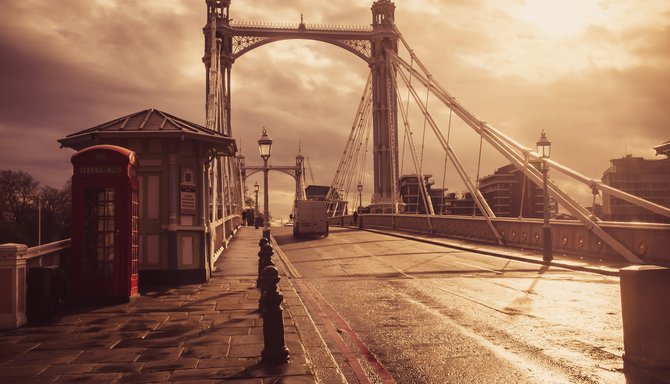Discover London's Albert Bridge
“One of the beauties of the London river.”
Albert Bridge, protected as a Grade II listed structure since 1975, is a vital transportation link connecting London’s Chelsea and Battersea districts. With its distinctive colour scheme – pink, blue, green – it is a striking Thames landmark, illuminated by thousands of low-voltage tungsten-halogen bulbs at night.
Over the years, the bridge has faced challenges, from traffic-induced structural damage to timber decay caused by canine activity. Despite these issues, Albert Bridge remains a symbol of resilience, carrying approximately 19,000 vehicles daily.

Creating the Albert Bridge
In the mid-19th century, the Battersea Bridge, dating back to 1771, had deteriorated, while the newer Victoria Bridge faced severe traffic issues. This caused Prince Albert to propose the construction of a toll bridge in 1860. The bridge would connect Battersea with Chelsea, aiming to alleviate congestion on existing crossings.
However, the proposal faced opposition from Battersea Bridge operators concerned about potential revenue loss. Eventually, an Act of Parliament in 1864 authorised the construction of the new bridge under the condition that it be completed within five years. The Albert Bridge Company agreed to compensate Battersea Bridge owners during construction and purchase their bridge upon completion.
Renowned engineer Rowland Mason Ordish was tasked with the design, employing his patented Ordish–Lefeuvre system. By 1873, the Albert Bridge was completed. Despite some structural issues with its design, the bridge transitioned into public ownership within six years, shedding the toll tax but retaining its iconic toll booths.
Today, despite relatively low traffic, Albert Bridge remains as one of the oldest original Thames crossings and a cherished London landmark.
Designing the Albert Bridge in London
Innovative Beginnings
Rowland Mason Ordish, renowned for his contributions to significant projects like the Albert Hall and St. Pancras Station, conceived a groundbreaking fusion of suspension and cable-stayed bridge designs for Albert Bridge. The bridge's innovative structure featured fan-like chains extending from ornate cast-iron towers, supported by vertical hangers, creating a striking silhouette against the London skyline.
Construction Challenges
Despite Ordish's expertise, the journey from concept to reality for Albert Bridge was filled with challenges. Construction, originally scheduled to begin in 1864, encountered delays due to negotiations over the proposed Chelsea Embankment.
In the interim period, Ordish constructed a similar bridge design in Prague, known as the Franz Joseph Bridge. However, setbacks persisted, necessitating a new Act of Parliament to extend the construction deadline.
Finally, in 1870, construction on Albert Bridge commenced, initially anticipated to conclude within a year at a cost of £70,000. However, the project exceeded expectations, lasting over three years and accumulating a final bill of £200,000. The bridge opened in 1873, nearly a decade after its authorisation, without any formal ceremony, highlighting the significant challenges faced during its construction.
Upon completion, Albert Bridge faced immediate challenges, notably with iron rods exhibiting signs of corrosion. Chief Engineer Sir Joseph Bazalgette's inspection in 1884 revealed the extent of deterioration, prompting remedial measures such as the addition of steel chains and a new timber deck.

Structural Weaknesses and Adaptations
Despite these improvements, worries persisted about the bridge’s structural integrity, leading to weight restrictions and ongoing maintenance efforts. In 1972, the Greater London Council (GLC) intervened, installing concrete piers in 1973 to support the bridge deck. This adaptation aimed to extend the bridge's lifespan while addressing its structural vulnerabilities.
There was also a motion put forth by the GLC to repurpose the bridge as a pedestrianised park. This was a popular proposal among the locals and was championed by Betjeman and Laurie Lee. However, maintaining the bridge’s purpose as a thoroughfare for traffic prevailed, resulting in its continued operation with regulated traffic flow.
In 1992, a distinctive colour scheme was introduced to enhance visibility and protect the bridge from collisions. Illuminated by LEDs at night, Albert Bridge has a timeless charm, attracting admirers from near and far.
The Trembling Lady
Albert Bridge earned the nickname "The Trembling Lady" because it used to vibrate, particularly when troops from nearby Chelsea Barracks marched across. Concerns about these vibrations led to precautionary measures, including warning signs urging troops to break step when crossing. Despite the closure of Chelsea Barracks, these signs remain as a reminder of the bridge's historical quirks.
Restoration and Renewal
Originally slated for an 18-month closure, the bridge’s renovation, which began on 15th February 2010, was extended to 22 months due to unforeseen deterioration. The refurbishment addressed various structural concerns, including the replacement of decayed timber decking and footways.

Additionally, the toll booths received refurbishment and twelve layers of paint were removed to expose the bare metal, which after being treated was given three fresh coats of paint. The project cost a total of £7.2 million, with the Royal Borough of Kensington and Chelsea contributing 25% of the funds, while the remaining 75% was provided by Transport for London.
The Albert Bridge was then proudly reopened on 2nd December 2011. The event involved a ceremonial crossing of two dogs named Prince and Albert from the nearby Battersea Dogs and Cats Home, and was a joyous occasion.
Explore London with CityDays
The best way to discover more hidden gems around London is to take your time and, ideally, have a pre-planned route that takes you past all the noteworthy nooks and hidden gems.
We can help you there!
The City combines the fun of an outdoor treasure hunt with the historic facts and whimsical trivia of a walking tour.
Answer riddles, solve puzzles and learn more about London’s 2000-year-old history in a new and interactive way - plus you get 20% off food and drink at a historic pub chosen by us!
Take the stress out of planning your visit to London and book your adventure today!
Not visiting London this time? Don’t worry, you’ll find us all over the world.











